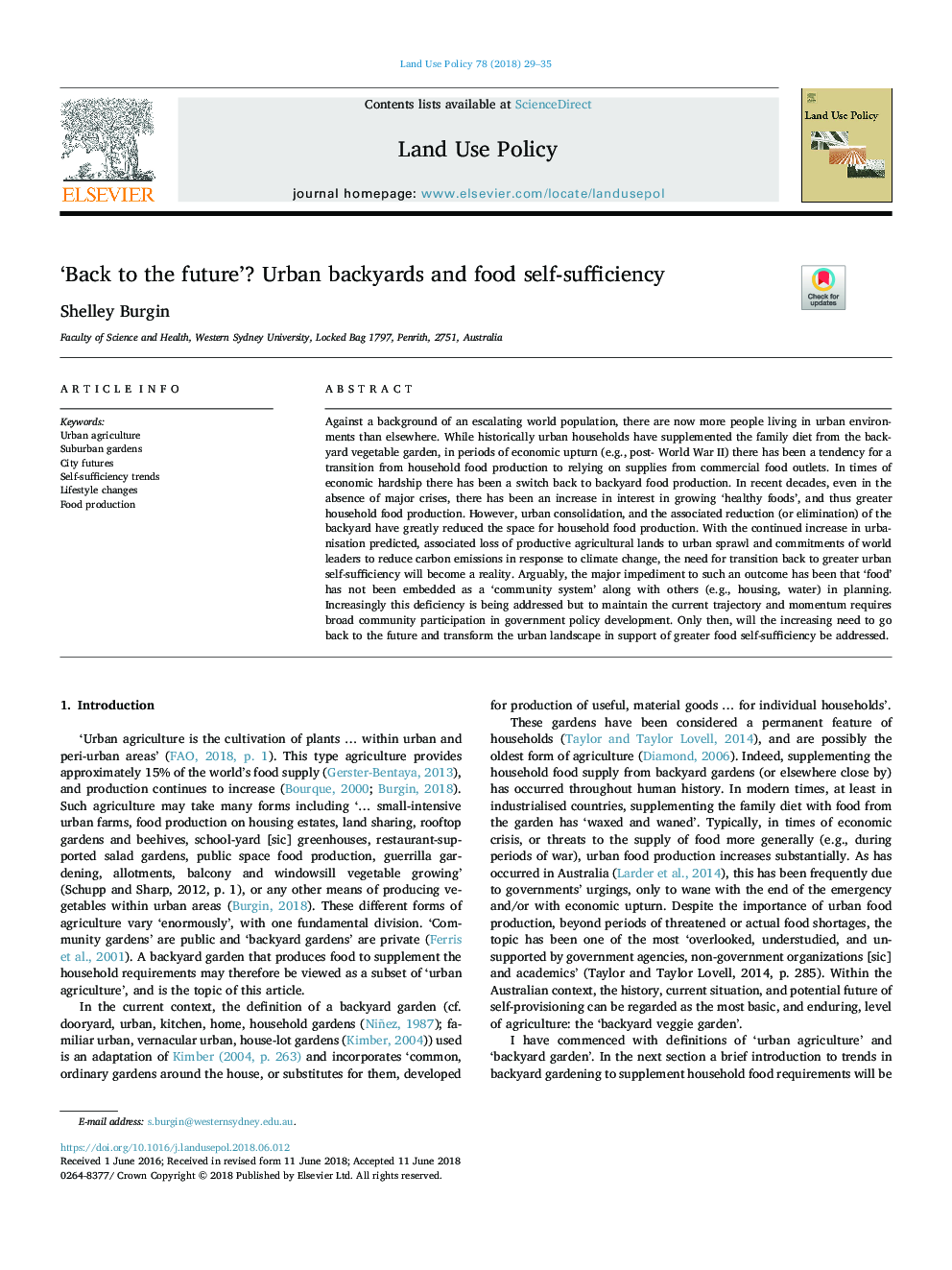| کد مقاله | کد نشریه | سال انتشار | مقاله انگلیسی | نسخه تمام متن |
|---|---|---|---|---|
| 6545998 | 1421805 | 2018 | 7 صفحه PDF | دانلود رایگان |
عنوان انگلیسی مقاله ISI
'Back to the future'? Urban backyards and food self-sufficiency
ترجمه فارسی عنوان
"بازگشت به آینده"؟ حیاط های شهری و خودمختاری غذایی
دانلود مقاله + سفارش ترجمه
دانلود مقاله ISI انگلیسی
رایگان برای ایرانیان
کلمات کلیدی
کشاورزی شهری، باغ های حومه، آینده شهر روندهای خودمختاری، تغییر سبک زندگی، تولید غذا،
ترجمه چکیده
در برابر یک پسوند جمعیت جهانی، مردم بیشتری در محیط های شهری زندگی می کنند که از هر جای دیگر. در حالی که خانواده های شهری از لحاظ تاریخی خانواده رژیم غذایی خود را از باغ سبزی حیاط خزر تکمیل کرده اند، در دوره های رونق اقتصادی (به عنوان مثال، پس از جنگ جهانی دوم)، تمایل به گذار از تولید مواد غذایی خانوار به تکیه بر تأمین منابع غذایی از بازار مواد غذایی وجود دارد. در مواقعی از مشکلات اقتصادی، برگشت به تولید مواد غذایی حیاط خلوت شده است. در دهه های اخیر، حتی در غیاب بحران های عمده، افزایش علاقه به رشد "غذاهای سالم" و در نتیجه تولید غذاهای خانگی بیشتر شده است. با این حال، تثبیت شهری و کاهش (یا حذف) آن در حیاط خلوت، فضای تولید مواد غذایی خانگی را بسیار کاهش داده است. با افزایش پیش بینی شده در شهرنشینی، از دست دادن زمین های تولیدی کشاورزی به فرسایش شهری و تعهدات رهبران جهان برای کاهش انتشار کربن در واکنش به تغییرات آب و هوایی، نیاز به گذار به افزایش خودکفایی شهری به یک واقعیت تبدیل می شود. مسلما مانع اصلی چنین نتیجه ای است که "غذا" در برنامه ریزی به عنوان "سیستم اجتماعی" همراه با دیگران (مثلا مسکن، آب) تعبیه نشده است. به طور فزاینده ای این کمبود در نظر گرفته می شود اما برای حفظ مسیر و جابجایی فعلی نیازمند مشارکت وسیع جامعه در توسعه سیاست های دولت است. تنها پس از آن، نیاز روزافزون به بازگشت به آینده و تبدیل چشم انداز شهری به حمایت از خودکفایی غذا بیشتر مورد توجه قرار گیرد.
موضوعات مرتبط
علوم زیستی و بیوفناوری
علوم کشاورزی و بیولوژیک
جنگلداری
چکیده انگلیسی
Against a background of an escalating world population, there are now more people living in urban environments than elsewhere. While historically urban households have supplemented the family diet from the backyard vegetable garden, in periods of economic upturn (e.g., post- World War II) there has been a tendency for a transition from household food production to relying on supplies from commercial food outlets. In times of economic hardship there has been a switch back to backyard food production. In recent decades, even in the absence of major crises, there has been an increase in interest in growing 'healthy foods', and thus greater household food production. However, urban consolidation, and the associated reduction (or elimination) of the backyard have greatly reduced the space for household food production. With the continued increase in urbanisation predicted, associated loss of productive agricultural lands to urban sprawl and commitments of world leaders to reduce carbon emissions in response to climate change, the need for transition back to greater urban self-sufficiency will become a reality. Arguably, the major impediment to such an outcome has been that 'food' has not been embedded as a 'community system' along with others (e.g., housing, water) in planning. Increasingly this deficiency is being addressed but to maintain the current trajectory and momentum requires broad community participation in government policy development. Only then, will the increasing need to go back to the future and transform the urban landscape in support of greater food self-sufficiency be addressed.
ناشر
Database: Elsevier - ScienceDirect (ساینس دایرکت)
Journal: Land Use Policy - Volume 78, November 2018, Pages 29-35
Journal: Land Use Policy - Volume 78, November 2018, Pages 29-35
نویسندگان
Shelley Burgin,
